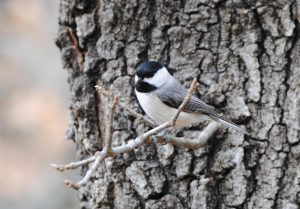Catepillars a Chickadee Feed Young Per Day

Planting natives is key to attracting birds like chickadees to your landscape. Natives attract and support insects, a key to helping birds raise their young.
For the first two years I tried xeriscaping in my yard, I planted coneflowers. Supposedly, coneflowers loved the sun, were drought tolerant, and attracted pollinators. What more could I ask for? The results were terrible, however, because they kept getting eaten by caterpillars before they'd had a chance to bloom. I'd try picking the caterpillars off when I found them munching happily away (if I caught them in time), but it was a futile effort. The next day more leaves had been devoured until my poor plants were practically gone. They never grew big enough to flower, and many didn't come back the next year. I was so frustrated I simply stopped planting coneflowers. I moved on to other plants, plants that wouldn't get ravaged by my hungry local fauna.
Picky chickadees
I didn't set out to select non-natives. But, plants like Russian sage and butterfly bush (Buddleia davidii ) didn't get eaten to the ground before they bloomed. Butterflies and other pollinators loved them when they were flowering, and that made them winners in my book.
It took me a while to realize that I was missing the bigger picture.
The first point I missed, of course, was that the evil caterpillars eating my coneflowers would eventually metamorphose into the very butterflies I was so keen to attract. In my ignorance, I was plucking future Silvery and Gorgone Checkerspot butterflies off the food they needed to reach adulthood. When I stopped planting coneflowers altogether, I was removing an important butterfly host plant from my yard.
The second thing I missed was far less obvious: Ninety-six percent of the birds in our yards are raised on insects. Bugs are for breakfast, lunch, dinner, and multiple snacks per day in baby bird world. In fact, a group of scientists from the University of Delaware conducting research on chickadee feeding patterns determined that it took between 5,000 to 9,000 insects to raise one brood of baby chickadees.
That's a lot of bugs! Last spring, I had at least two pairs of chickadees that had successful hatchings in my yard. I also had wrens, woodpeckers, titmice, and bluebirds feeding young at the same time. The bug numbers needed to feed all these hungry baby birds is a little mind-boggling.
Researching (Again)
But back to the research. While studying one particular nest, the researchers noticed that the chickadee mom would skip a nearby ginko tree and two crepe myrtles to fly a much longer distance to forage for bugs on a willow oak. Why? For the same reason that coneflowers get eaten by caterpillars while my Russian Sage does not. Willow oaks are natives; ginkos and crepe myrtles aren't. Native insects have evolved to eat native plants.
The chemical defenses of foreign plants are more effective at protecting them from our native bugs. They tend to be more pest and insect-free. Momma chickadee knew that she would have more luck finding bugs on a native tree than those non-native plants. (Even though they were closer.) It was more efficient for her to fly a longer distance to a more certain food source than it was to waste time and energy hunting around on the non-natives.
This, in a nutshell, is why it is so important to plant native trees, shrubs, and plants in our gardens and landscapes, particularly if we want to support local wildlife. Natives are great BECAUSE they get eaten by bugs and insects. Now, when I see my coneflowers getting munched into oblivion by caterpillars? I think, "Yes! The bird buffet is open!" I know I will either have fun young chickadees frolicking in my woods in late spring, or I'll have beautiful checkerspot butterflies fluttering about in summer and fall. And it's not so frustrating after all.
Source: https://plantersplace.com/wild-life-gardening-journal/how-many-bugs-does-it-take-to-raise-a-brood-of-chickadees/